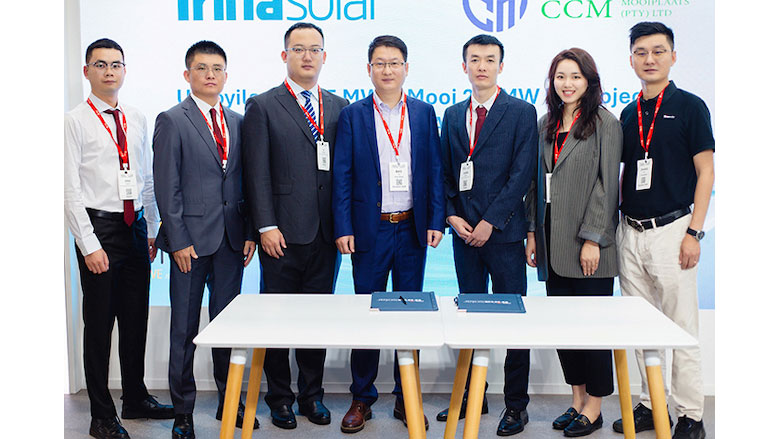Chinese Solar Firm Picks Partners for 283-MW South Africa PV Project


Trina Solar Co.’s partnership with China Energy International Group and China Gezhouba Group will help accelerate the Mooi Plaats solar PV project.
Photo Courtesy Trina Solar Co.
Chinese solar photovoltaic and energy storage systems firm Trina Solar Co., Ltd has announced a new partnership with China Energy International Group and China Gezhouba Group for the installation of the 283-MW Mooi Plaats solar photovoltaic power project in South Africa.
The project, located approximately 18.5 km southwest of Noupoort in the Northern Cape Province, is being developed by Envusa Energy, a joint venture between London-based multinational mining firm Anglo American and EDF Renewables, a wholly owned subsidiary of French utility EDF Group.
Mooi Plaats, which is expected to be completed in 22 months, also entails installation of 132-kV overhead power line and 33/132-kV on-site substations. The project will connect to the new Koruson 400-kV Main Transmission Substation that is under construction by EDF Renewables.
EDF Renewables in conjunction with South Africa’s local financial institutes is financing the project that will harness the power of at least 416,325 NEG21C.20 Vertex N panels manufactured by Trina Solar Ltd.
Trina says each panel will be approximately 2 meters wide and between 1 m and 4 m in height depending on the mounting style.
“We are proud to partner with China Energy International Group and China Gezhouba Group to bring this groundbreaking project to fruition,” said Bao Yang, president, global sales and marketing at Trina Solar.
“We are proud to contribute our expertise to this project, which will not only deliver clean, reliable power but also drive economic growth and job creation in the region,” said Chen Zhipei, Mooi Plaats project manager of China Gezhouba Group.
The Mooi Plaats solar project is important for Anglo American, as the British mining company is investing in clean energy projects as part of its strategy to address its carbon emissions associated with existing electricity generation in South Africa.
“As we make progress towards our 2040 carbon-neutral operations commitment, we also see the opportunity to enhance energy reliability and grid resilience in South Africa,” Themba Mkhwanazi, Anglo American’s regional director for Africa and Australia said previously.
Apart from the Mooi Plaats solar project, the joint venture is also developing the Umsobomvu and Hartebeesthoek wind project, each with capacities of 140 MW. They form part of the Envusa Energy’s mature pipeline of wind and solar projects in South Africa.
The advantage of locating the wind and solar projects in Hydra Central area astride the border of Northern and Eastern provinces is the expected “outstanding yield resources, coupled with a robust Eskom grid connection hence making it possible to achieve “considerable electricity cost savings compared to existing tariffs.”
Already, Anglo American’s three businesses in South Africa that include Anglo American Platinum, Kumba Iron Ore, and De Beers, have committed to 20-year offtake agreements with Envusa Energy.
Anglo American Platinum would receive 461 MW of supply while Kolomela and Venetia mines will get 11 MW and 48 MW of the generated power respectively.
Initial project implementation timelines indicate Mooi Plaats and the other two wind projects are scheduled to reach commercial operation during 2026 with the capacity to abate approximately 2.2 million tonnes per year of carbon dioxide.
The biggest challenge the Mooi Plaats project will be grappling with is the depletion of generation connection capacity within the project area, which according to Eskom, South Africa’s biggest public utility, “has resulted in many generation projects being denied connection.”
“These areas remain in high demand due to their abundant energy resources for renewable generation. Unlocking capacity in these areas will require a significant amount of transmission network investment, which often takes several years to develop and construct,” Eskom says.
The capacity has been depleted from previous bid window rounds and private off-takers.
The state-run power utility adds the depletion of generation connection capacity “has resulted in many generation projects being denied connection.”
Going forward, Eskom says huge investment is needed in transmission network help unlock capacity in these areas, especially in Hydra Central region, where Mooi Plaats project is located.



